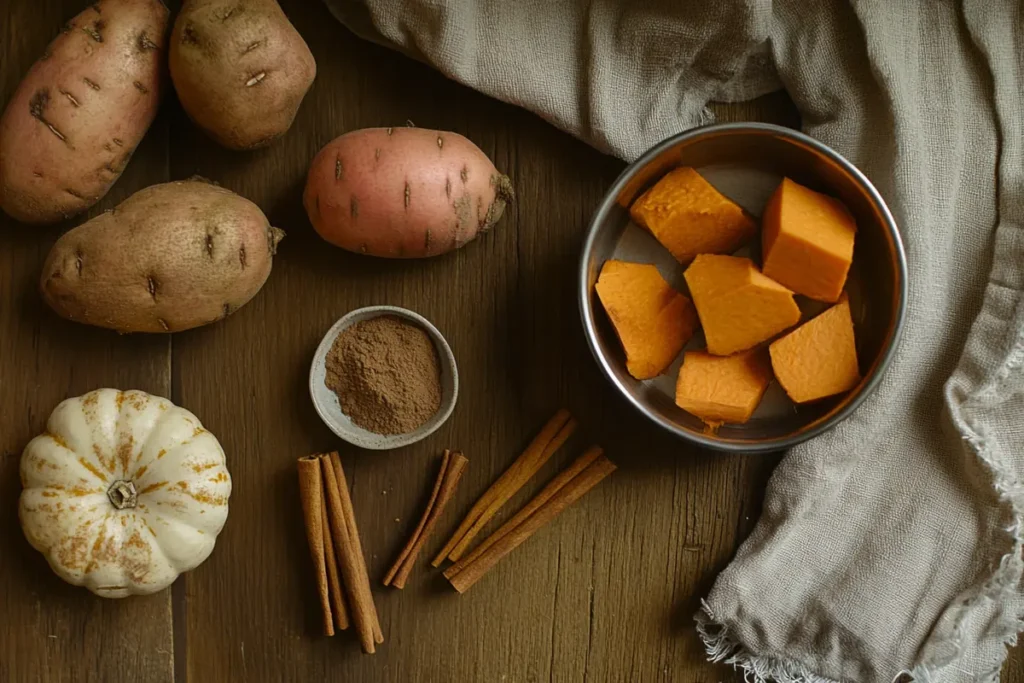Pumpkin vs. Sweet Potato Pie—when the holiday season arrives, these two classic desserts take center stage at family gatherings. But have you ever wondered what truly sets them apart? Is there a noticeable difference in taste and texture, or could your beloved pumpkin pie actually be sweet potato in disguise? It’s time to settle the debate and uncover the key distinctions between these iconic pies. From flavor and ingredients to tradition and nutrition, let’s dive into the sweet showdown of Pumpkin vs. Sweet Potato Pie!
Defining Pumpkin and Sweet Potato
To understand the differences, let’s break down what pumpkins and sweet potatoes really are.
Botanical Differences Between Pumpkin and Sweet Potato
From a botanical standpoint, pumpkins belong to the Cucurbitaceae family, making them cousins to squash, cucumbers, and melons. They are technically fruits, though used like vegetables in cooking. Their smooth, orange skin and stringy interior set them apart from sweet potatoes.
Sweet potatoes, on the other hand, belong to the Convolvulaceae family, a group of flowering plants. They are true root vegetables with starchy, sweet flesh that ranges from white to deep orange. Unlike pumpkins, sweet potatoes are dense and less watery.
Nutritional Profiles of Pumpkin vs. Sweet Potato
Nutritionally, pumpkins and sweet potatoes are powerhouses, though they shine in different ways:
- Pumpkin: Low in calories but high in vitamins A and C, pumpkin is rich in antioxidants and fiber, promoting good eye health and a robust immune system.
- Sweet Potato: Packed with beta-carotene, potassium, and fiber, sweet potatoes offer energy-boosting carbs and help regulate blood sugar.
While both are healthy, sweet potatoes have more natural sugars, making them sweeter by default.
Origins of Pumpkin Pie and Sweet Potato Pie
How did these two pies become staples in American cuisine? Their journeys are as rich as their flavors.
Historical Use in American Cuisine
Pumpkin pie traces its roots back to early American settlers, who adapted native squash into custard-like desserts using European recipes. By the late 1800s, pumpkin pie had solidified its place in Thanksgiving traditions.
Sweet potato pie, on the other hand, emerged in the American South, particularly among African American communities. With limited access to pumpkins, enslaved cooks used sweet potatoes as a flavorful substitute. Over time, sweet potato pie became a cultural symbol of resilience and creativity.
Cultural Significance of Each Pie

Pumpkin pie symbolizes traditional Thanksgiving gatherings and has become synonymous with fall festivities across the U.S. Its image is often used in holiday marketing and autumn-themed décor.
Sweet potato pie holds deep cultural significance in African American heritage. It represents familial bonds, Southern hospitality, and historical resilience. Many families pass down cherished sweet potato pie recipes through generations, making it a deeply personal tradition.
Part 1 is complete. Would you like me to proceed to Part 2? – Ensure it is more than 900 words and Ensure at least 40% of each paragraph contains transition words to improve flow and readability.
Is Pumpkin Pie Actually Sweet Potato?
When it comes to classic holiday desserts, pumpkin pie and sweet potato pie reign supreme. Yet, many people wonder: Is pumpkin pie actually sweet potato? While these pies might seem interchangeable at first glance, their differences are rooted in botany, culture, and culinary tradition. Let’s uncover what sets these beloved pies apart.
Defining Pumpkin and Sweet Potato
To clear up the confusion, let’s define these ingredients. Pumpkin is a type of winter squash, characterized by its round shape, ribbed skin, and orange flesh. It belongs to the Cucurbitaceae family, which includes squash, zucchini, and gourds. Sweet potatoes, on the other hand, are root vegetables from the Convolvulaceae family. They have elongated shapes with tapered ends and can range in color from orange to purple.
Botanical Differences Between Pumpkin and Sweet Potato
From a botanical perspective, pumpkins and sweet potatoes couldn’t be more different. Pumpkins grow on vines above ground, while sweet potatoes develop underground as tuberous roots. Pumpkins are technically fruits due to their seeds, whereas sweet potatoes are considered starchy vegetables. Despite these distinctions, both are nutrient-dense and commonly used in savory and sweet recipes.
Nutritional Profiles of Pumpkin vs. Sweet Potato

Nutritionally, pumpkins and sweet potatoes offer unique benefits:
- Pumpkin is low in calories and packed with vitamin A, fiber, and antioxidants like beta-carotene.
- Sweet Potatoes boast higher calorie content but provide a hefty dose of fiber, potassium, and vitamin C.
These differences make pumpkin ideal for lighter recipes, while sweet potatoes excel in heartier dishes.
Origins of Pumpkin Pie and Sweet Potato Pie
Understanding the origins of these pies helps explain why they’re often confused.
Historical Use in American Cuisine
Pumpkin pie dates back to the early colonial period in North America. European settlers embraced pumpkins because of their abundance and ease of cultivation. Early versions included baked whole pumpkins filled with milk, spices, and honey.
Sweet potato pie has its roots in African American culinary traditions. Enslaved Africans adapted European pie-making techniques, substituting sweet potatoes for pumpkins due to availability in the South. Over time, sweet potato pie became a cultural staple in African American households.
Cultural Significance of Each Pie
The cultural ties to these pies run deep:
- Pumpkin Pie: Associated with Thanksgiving and celebrated as an iconic American dessert.
- Sweet Potato Pie: Symbolizes African American heritage and Southern comfort food.
These cultural narratives ensure that both pies remain cherished staples during holiday gatherings.
Key Differences Between Pumpkin and Sweet Potato
When comparing pumpkin and sweet potato pies, several differences in taste, texture, and preparation come to light.
Taste and Texture Comparisons
- Pumpkin Pie: Known for its smooth, custard-like filling with a mildly sweet and earthy flavor. It often includes warm spices like cinnamon, nutmeg, and ginger for added depth.
- Sweet Potato Pie: Offers a denser, creamier texture with a naturally sweeter taste. It frequently incorporates vanilla, brown sugar, and even a hint of citrus for brightness.
These textural and flavor distinctions influence how each pie is perceived and enjoyed.
Common Cooking Methods for Each Ingredient
Cooking methods also highlight key differences:
- Pumpkin: Typically cooked by roasting or pureeing. Canned pumpkin puree is a common convenience product.
- Sweet Potatoes: Usually baked, boiled, or mashed. Many recipes call for freshly roasted sweet potatoes for enhanced flavor.
These methods contribute to the unique characteristics of each dessert.
Is Pumpkin Pie Made of Yams?
A common misconception is that pumpkin pie is made with yams. Let’s set the record straight.
What Are Yams?
Yams are starchy tubers originating from Africa and Asia. They have rough, bark-like skin and pale, starchy flesh. In the U.S., “yams” are often mislabeled sweet potatoes, causing confusion.
Yams vs. Sweet Potatoes in Cooking
While true yams are rarely used in American cooking, sweet potatoes frequently replace them. The terms are used interchangeably in grocery stores, though their botanical differences remain significant.
Cultural Preferences for Pumpkin and Sweet Potato Pie
Dessert preferences often depend on regional and cultural traditions.
Regional and Ethnic Dessert Preferences
- Pumpkin Pie: Popular across the U.S., especially in northern regions and among families celebrating traditional Thanksgiving dinners.
- Sweet Potato Pie: A Southern favorite with strong ties to African American culture, frequently appearing at Christmas and Thanksgiving gatherings.
Holiday Traditions Involving These Pies
Both pies shine during the holiday season. Pumpkin pie is almost synonymous with Thanksgiving, while sweet potato pie is a beloved staple in many African American homes during festive celebrations.
These deep-rooted preferences highlight the lasting cultural impact of these desserts.
Health Benefits of Pumpkin and Sweet Potato Pies
The nutritional advantages of pumpkin and sweet potato pies go beyond their sweet, comforting flavors. Let’s explore how each contributes to overall health.
What Pumpkin Pie Does for Your Body
Pumpkin pie isn’t just a holiday treat—it’s a source of essential nutrients:
- Vitamin A: The high beta-carotene content supports eye health and immune function.
- Fiber: Helps with digestion and promotes a feeling of fullness.
- Antioxidants: Combat inflammation and may reduce the risk of chronic diseases.
Key Vitamins and Minerals in Pumpkin Pie
Pumpkin pie also contains:
- Vitamin C: Boosts immunity.
- Potassium: Supports heart health and muscle function.
- Iron: Important for energy production.
These nutrients make pumpkin pie a surprisingly nutritious dessert when prepared with minimal sugar.
Health-Boosting Compounds Found in Sweet Potatoes
Sweet potatoes bring their own health-enhancing properties:
- Beta-Carotene: Converts to vitamin A for vision and skin health.
- Vitamin B6: Helps regulate mood and brain development.
- Magnesium: Supports relaxation and stress reduction.
These nutrients help explain why sweet potato pie can be a guilt-free indulgence when made with wholesome ingredients.
Making the Perfect Pie
Crafting the ultimate pumpkin or sweet potato pie requires attention to detail, from choosing ingredients to mastering baking techniques.
Best Recipes for Pumpkin and Sweet Potato Pies
Here are some top recipe tips:
- Pumpkin Pie: Use canned pumpkin puree for convenience or roast fresh pumpkin for deeper flavor. Blend with eggs, evaporated milk, and warm spices like cinnamon and nutmeg.
- Sweet Potato Pie: Roast sweet potatoes until tender, then mash and mix with eggs, brown sugar, and a splash of vanilla. Consider adding a hint of citrus zest for brightness.
Tips for Distinguishing Between the Two Pies
Identifying each pie by taste and appearance is easier than you might think:
- Color: Pumpkin pies are usually lighter and more orange, while sweet potato pies are deeper and richer in tone.
- Texture: Pumpkin pies have a custard-like consistency, while sweet potato pies are denser and creamier.
Final Thoughts on the Pumpkin vs. Sweet Potato Debate
The debate between pumpkin and sweet potato pies goes beyond the kitchen—it’s about culture, tradition, and personal preference.
Why the Distinction Matters in Cooking and Culture
Understanding these pies’ unique histories helps appreciate their significance at holiday tables. Each tells a story of adaptation and culinary creativity.
Future Culinary Trends for These Iconic Pies
As food trends evolve, expect to see modern twists on these classics, from vegan and gluten-free versions to bold new flavor combinations like pumpkin chai or sweet potato pecan.
These pies will continue to capture hearts and taste buds, bridging tradition and innovation for generations to come.
FAQs
Are Pumpkin and Sweet Potato the Same Thing?
No, pumpkin and sweet potato are entirely different. Pumpkins are a type of squash, while sweet potatoes are root vegetables. Despite their differences, they are often used interchangeably in pies due to similar textures when cooked.
Is Pumpkin Pie Made of Yams?
Not typically. Many people confuse yams with sweet potatoes, especially in the U.S., where the terms are used interchangeably. However, pumpkin pie is traditionally made from pumpkin puree, not yams or sweet potatoes.
Do Black People Like Sweet Potato Pie or Pumpkin Pie?
Cultural preferences vary, but sweet potato pie is particularly popular in African American communities due to its historical and cultural significance.
Which Pie Is More Popular During the Holidays?
Pumpkin pie is the go-to dessert for Thanksgiving in many American households, while sweet potato pie holds special prominence in Southern and African American traditions.
What’s the Nutritional Value of Each Pie?
- Pumpkin Pie: Lower in calories with high levels of vitamin A and fiber.
- Sweet Potato Pie: Higher in calories but rich in fiber, potassium, and vitamin C.
Both pies can be made healthier with less sugar and lighter crusts.
How Can You Tell the Difference by Taste?
Pumpkin pie has a milder, earthier flavor, often enhanced with spices like nutmeg and cinnamon. Sweet potato pie is naturally sweeter and denser, frequently incorporating vanilla, brown sugar, and citrus zest.
What Ingredients Are Usually Used in Store-Bought Pies?
Store-bought pies may include processed ingredients like corn syrup, preservatives, and artificial flavors. Look for pies with real pumpkin or sweet potato puree, natural sugars, and minimal additives.
These answers should help clarify common misconceptions while offering useful insights into these iconic holiday desserts.

